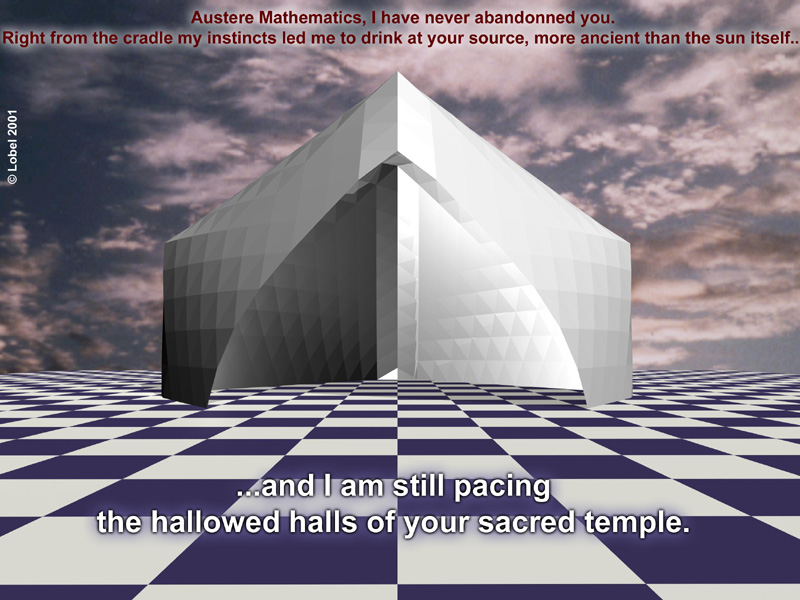Homepage Fundamental
Research Intro Families Applied Research
Mass Production Connectors Covering Air lifted Light Structures Projects Gallery Contact News Publishing Guestbook FAQ Contact
printed from www.equilatere.net
FORMS AND STRUCTURES GENERATED BY IDENTICAL ELEMENTS

Engineer Alfred Noble (South Africa) called theses shapes "Lobel Frames" at Guildford conference in 1993 where they were introduced.
To be able to produce diversity from uniformity
Since the forties,a time when we witnessed various attempts to divide the sphere,(Bauersfeld and Fuller),a great deal of research has been concentrated on the equal division of space, with the obvious objective of industrialization (Peter Pearce).
Of course, dividing a flat surface or of single curvature offers little difficulty. The problem begins when it is a question of creating surfaces described as having a double curvature which have a rigid form. It should be noted however that the term double curvature loses something of its meaning when it is applied to surfaces with facets which have no tangents.
This is the problem on which I have concentrated for several years and to which I have found several solutions which I shall present here.
It might seem strange that it has taken so many years to unearth these forms. There is a possible explanation for this : When an idea surfaces you need to step outside traditional patterns of thought to allow that idea to develop its own momentum. Did not Leonardo da Vinci draw up planes for a flying machine with moving wings?

The first motor cars were initially held back by being pinned down to memories of the horse drawn carriages which came before them.
Likewise, research into the equal division of space was bent on making use of volumes already existing in classical geometry.
I started out in this way, until I realised it was getting me nowhere. Then I turned the problem on its head.
1/ In view of the fact that I needed to arrive at: equal segments.
2/ In view of the fact that I needed triangles because they are geometrically indeformable: I needed equilateral triangles.
My question now became :
What volumes are possible based on a single module: The equilateral triangle ?
From this moment the problem was correctly set, and answers were quickly found.
I then spent 5 years, off and on, working out a system of calculation and then writing a computer program capable of creating a first family of forms, the C3.
In studying a phenomenon, it often emerges that its manifestation is governed by an infinity of criteria. These influence and control the phenomenon in its different states, and then to select those which are more interesting for the attainment of a given aim.
I realised relatively quickly that there existed many families of forms and within each family there existed thousands of forms.
At present I have listed individual types within nine families.
In chronological order of their discovery these are :
Likewise, research into the equal division of space was bent on making use of volumes already existing in classical geometry.
I started out in this way, until I realised it was getting me nowhere. Then I turned the problem on its head.
1/ In view of the fact that I needed to arrive at: equal segments.
2/ In view of the fact that I needed triangles because they are geometrically indeformable: I needed equilateral triangles.
My question now became :
What volumes are possible based on a single module: The equilateral triangle ?
From this moment the problem was correctly set, and answers were quickly found.
I then spent 5 years, off and on, working out a system of calculation and then writing a computer program capable of creating a first family of forms, the C3.
In studying a phenomenon, it often emerges that its manifestation is governed by an infinity of criteria. These influence and control the phenomenon in its different states, and then to select those which are more interesting for the attainment of a given aim.
I realised relatively quickly that there existed many families of forms and within each family there existed thousands of forms.
At present I have listed individual types within nine families.
In chronological order of their discovery these are :

The first two .C3 and .C6 are called open forms, in that they rest on separated supports between which there are gaps.
The following seven .CSM /.CUB / .3P / .TRA / .PNT / .POT / HGR
are called closed forms in that they form volumes enclosed on themselves.
Characteristics common to all these forms :
1/ All the struts are of identical length.
2/ These struts are linked to one another so as to form triangles which are therefore equilateral.
3/ The struts are never an extension of one another.
4/ The angle of the facets is sometimes directed inwards,sometimes outwards.
(Folded structures,concave/convex,with a majority convex.)
5/ In rigidifying certain points of a form (the edges for example) the whole form is geometrically rigid.
Just as bricks are manufactured without knowing in advance the use to which they will be put, it is not necessary to know what the future form will be in order to industrialize its elements.
The following seven .CSM /.CUB / .3P / .TRA / .PNT / .POT / HGR
are called closed forms in that they form volumes enclosed on themselves.
Characteristics common to all these forms :
1/ All the struts are of identical length.
2/ These struts are linked to one another so as to form triangles which are therefore equilateral.
3/ The struts are never an extension of one another.
4/ The angle of the facets is sometimes directed inwards,sometimes outwards.
(Folded structures,concave/convex,with a majority convex.)
5/ In rigidifying certain points of a form (the edges for example) the whole form is geometrically rigid.
Just as bricks are manufactured without knowing in advance the use to which they will be put, it is not necessary to know what the future form will be in order to industrialize its elements.